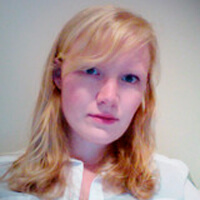Emma Powell is an artist in residence and lecturer in photography at Iowa State University. Powell graduated from the College of Wooster in Ohio and received her MFA from Rochester Institute of Technology. Her work often examines photography's history while incorporating historic processes and or devices within the imagery. In her series In Search of Sleep, Powell uses the cyanotype process to create a visual lullaby in wish she explores personal narratives and metaphors.
In Search of Sleep
From my earliest days I have had a difficult relationship with sleep. As a child I avoided it at all costs, especially at night. To get me back to bed, my father used to tell me stories. They were not traditional children’s bedtime stories, but invented tales that began on our quiet street and journeyed down open drains to a dream-world of caverns, forests, and oceans full of unexpected animals and dangers. The story would always find its way back to the real world and end where it had begun, hopefully but doubtfully with me that much closer to sleep.
In Search of Sleep recreates this shadowy realm and allows me to explore my real-life questions, from personal dramas to romantic doubts. The cyanotype process, with its distinctive blue tones, visually traverses the distance between waking and sleeping. These images are also toned with tea and wine to both dull the blues and add warmth. Tea, wine, cyanide – all three of these substances relate to different levels of consciousness that often mirror the mental states evoked by my photographs. In Search of Sleep creates a visual lullaby that allows me to safely explore what I love, what I fear, what I remember, and what I imagine.
